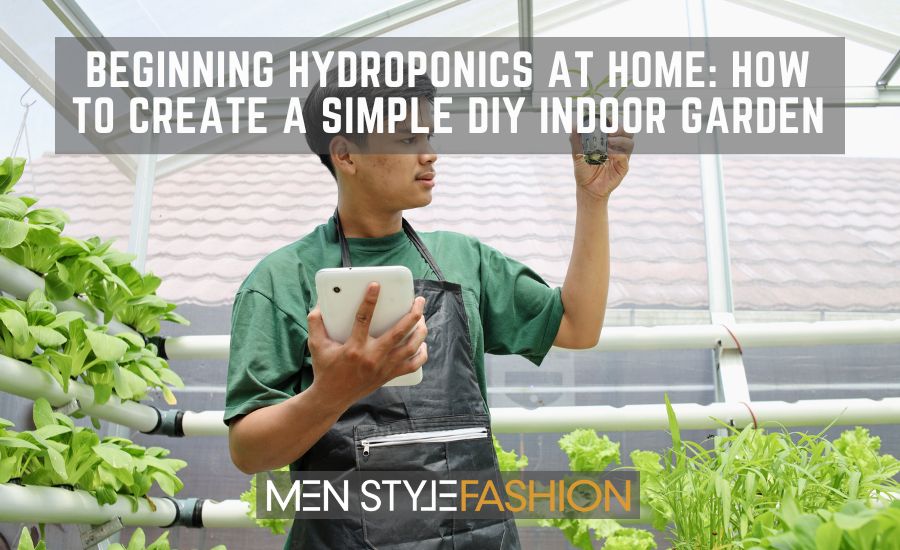Menswear’s Next Breakout Brands: 12 Labels Under 100K Followers On Instagram
Dec 22, 2025Beginning Hydroponics at Home – How to Create a Simple DIY Indoor Garden
- Aug 13, 2023
- 0 Comments
555

Hydroponics is a soilless technique of raising plants using a nutrient solution. Since the roots of plants have direct access to oxygen and all the essential nutrients, hydroponics planter systems are, in most cases, more water-efficient and faster. On top of that, they require a small space, as they can utilize tight corners, walls, and windows.
Hydroponic gardening is well-suited for urban dwellers who don’t have enough space for outdoor farming. Plant aficionados looking to take their indoor gardening game to a new level can either purchase readymade hydroponics systems or make simple DIY indoor gardens and side-step all the drawbacks that soil gardening offers.
While the basic principles are the same across different hydroponics gardens, a vast array of techniques are available with a huge range of sizes and substrates. If you visit the Gardyn reviews page, you can see how users of different hydroponics systems have provided varying feedback about their indoor gardens.
The feedback can help you pick a hydroponic system that best suits your unique needs and requirements. Let’s discover more about hydroponics gardening, including how you can create your first DIY indoor garden.
What’s an Indoor Hydroponics Garden?
First things first – you need to know what you’re getting into before creating a simple DIY hydroponics system at home. Hydroponics gardening eliminates the need for soil since it takes advantage of light and water power.
As a gardener, you require special solutions to create a friendly environment for your crops to grow healthy and faster. Usually, readymade hydroponics gardens will come with all components, allowing you to get started immediately. They come with:
- Multiple pods for users to pop their seeds into
- Nutrients
- Integrated light systems
- Automatic features such as pH adjusters, pumps, etc.
With all these features, growing plants indoors is super easy. Sometimes, hydroponics systems are referred to as smart gardens since they use the latest technology, such as artificial intelligence, to grow plants. Some of them have mobile applications that allow users to manage their plants and gardens anywhere, anytime.
How Does a Hydroponic Garden Work?
Plants usually require nutrients, water, oxygen, and carbon dioxide to manufacture food and grow healthy. The soil provides much-needed support, nutrients, and water. However, hydroponics gardening involves raising plants in water that contains nutrients. The latest hydroponics systems are programmed to make sure plants receive everything they need to thrive.
Based on your hydroponics system of your choice, roots of your plants can be placed directly in the nutrient solution or growing media, which may include the following:
- Coconut fiber
- Perlite
- Clay pebbles
- Peat moss
The nutrient-enriched water and growing media allow plants to receive all the necessary nutrients they require to grow. Plant stems, and leaves are usually outside to receive light from the sun or grow lights. They also access carbon dioxide to allow them to create food.
A hydroponics garden has a reservoir, a pump, and an airstone. These components help the system to supply the plants with oxygen, water, and nutrients. As you can see, a hydroponics planter system creates a perfect environment that plants require without soil.
Building a Simple DIY Indoor Hydroponic Gardening System
It’s true that you now have enough information to help you create a simple DIY indoor hydroponics garden. The hydroponics systems available include the following:
- Wick hydroponics system
- Deep water culture hydroponics system
- Ebb and flow hydroponics system
- Vertical hydroponics system
- Nutrient film technique system
- Drip hydroponics system
In this section, you’ll learn how to create simple and cost-effective DIY indoor hydroponics gardening systems, which include a wick system, deep water culture, and Ebb and flow. Let’s learn how to create each one of them at home.
Indoor Wick Hydroponics System
An indoor wick hydroponics system is the simplest and easiest to create at home. You only need three key components, which include wicks, a growing tray, and a reservoir. In a wick hydroponics system, plant roots are placed in a growing media, with the reservoir installed below.
A rope or string wick connects the plant roots with the nutrient-enriched water. An indoor wick hydroponics system is a perfect choice if you want to grow microgreens and herbs. It isn’t a perfect match for tomatoes or leafy greens.
What You Need
- A reservoir like a three-gallon bucket
- Wicks
- A growing tray with a growing media
Steps You Need to Follow
- Fill up your reservoir with the nutrient-enriched water
- Place several wicks or strings at the bottom of your growing tray and then connect it to the reservoir
- Sow the plants or seedlings over the reservoir – the wick will distribute the nutrient-enriched solution to the roots of plants
Indoor Deep Water Culture System
The deep water culture garden is another simple and cost-effective system you can create at home comfortably. The plant roots are immersed in aerated water, where they obtain oxygen and nutrients. An indoor deep water culture system requires an airstone and pump to ensure the solution is oxygenated.
What You Need
- Net pots
- Styrofoam – to use as a raft
- A three- or five-gallon bucket/opaque storage container
- Air stone
- Air pump
- X-ACTO knife – to help cut the Styrofoam platform
Steps You Need to Follow
- Add a water and nutrients solution to your bucket/opaque storage container up to a minimum of 12 inches
- Install your air stone into the solution and then connect it to the air pump placed near the reservoir
- Cut your Styrofoam to create a raft that can excellently sit and float approximately 1 inch below the top of the reservoir/container
- Place your plants in the net pots and install them in the holes you created on the Styrofoam raft
Ebb and Flow
While this system is a little complex and technical, it provides greater versatility. It works by flooding and draining the system reservoir periodically depending on the needs and requirements of the plants and their growth cycle.
During flooding, the nutrient-enriched water moves through the system, providing much-needed hydration and nutrients to the crops. And when it comes to draining, the nutrient solution goes back to the reservoir to be reused. A pump helps flood and drain your system’s growing tray.
What You Need
- Electronic timer
- A submersible pump
- Drain and fill tubes
Steps You Need to Follow
- Place your reservoir directly below the growing tray
- Place the seedlings in net pots with drainage holes – ensure the pots are taller than the growing tray
- Use drain and fill tubes to connect your reservoir to the flood tray – make sure the other end of the full tube connects to the pump
- Set up your pump and use the timer to program how often to drain and flood the plants
Up to this point, you’ve got two options; purchase a readymade indoor hydroponics garden, or create one. If creating one feels overwhelming, find a top-rated provider and purchase your favourite hydroponics system type.
A ready-made hydroponics system will enable you to get started in no time, and the best part is that it offers numerous benefits, from ease of maintenance and control to space saving. Make your choice today!
Publisher: Source link







